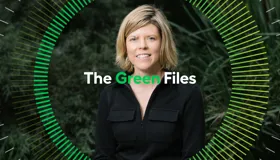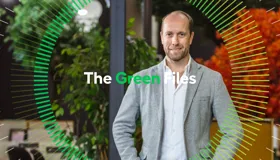
Powering homes, saving energy: One year of the HEUF
The Green Files is a unique CEFC series where we talk to the people making a difference in the race to net zero emissions.
Since its launch, the $1 billion Household Energy Upgrades Fund’s TM (HEUF) rapid pace of success has surprised even one of its lead architects. One year in, Grace Tam, CEFC Head of Consumer Finance and passionate advocate for making energy efficiency accessible to all Australians, discusses how the fund is building strong momentum among households, financial institutions and home energy specialists.
Say ‘clean energy transition’ and many people think of headline-grabbing wind and solar farms.
When I joined the CEFC in 2017, public knowledge was focused on those large-scale projects, which are, of course, important to our renewable transition. But with a background in mortgage lending, my focus has always been at the smaller scale – individual households and their budgets.
In my early days at the CEFC, I pursued my interest in energy efficient housing by attending locally based industry forums. At one of those events, I was dismayed to hear a story about a Sydney family having to spend their evenings in a 24-hour supermarket to escape their poorly insulated home during the 40 plus degree summer heat. This was not an isolated case I learned, as the majority of homes in Australia haven’t been built with energy efficiency in mind.
Helping householders improve energy efficiency is one of the quickest ways we can move closer to net zero and make a tangible difference for everyday Australians.Grace TamHead of Consumer Finance, CEFC
That motivated me to take a deep dive into what was happening in the green home loan sphere overseas, and in particular the Fannie Mae green home loans program in the USA.
My research fed into the first CEFC green loans program with Bank Australia in 2020 to provide a choice of technologies and discounted finance and encourage homeowners to invest to improve their home energy performance. The uptake of those loans was huge.
I wanted to understand what we could do to improve housing in Australia, which led to an Eisenhower Fellowship in the US where I had the opportunity to learn from home energy experts and governments.
When the opportunity then arose to propose a government-backed green loan program, we put together everything we’d learnt from Australia and overseas with a simple but important goal: To help everyday Australians save energy without being overwhelmed by cost or complexity.
A year on from the launch of the first HEUF co-financing facility, I’m proud to say the HEUF is doing exactly that and continuing to build on this momentum.
Upgrading homes, lives and net zero gains
Through the HEUF we work with leading co-financiers who offer their customers discounted loans for home energy upgrades, including solar PV, batteries, insulation, air-conditioning and more.
Facilitating these switches is vital given residential homes contribute around 24 per cent of overall electricity use and more than 10 per cent of Australia's carbon emissions1.
Right now, about 70 per cent of existing Australian homes are estimated to rate 3 stars or lower on the Nationwide House Energy Rating Scheme (NatHERS) scale. Improving from just 3 to 5 stars could reduce the energy needed for heating and cooling by around 40 per cent2.
Helping householders improve energy efficiency is one of the quickest ways we can move closer to net zero and make a tangible difference for everyday Australians.
Australians want lower energy bills and to reduce their household emissions, but high upfront costs can be a deterrent. Discounted finance can help households overcome initial cost barriers and help unlock faster uptake of energy efficiency equipment, reducing energy bills.
Aside from environmental and ongoing cost of living benefits, the upgrades have major positive impacts on health and wellbeing. That’s especially the case for people who have previously avoided using heaters or coolers in extreme weather because of the cost.
I’ve seen the advantages first-hand in the seven-star rated home where my aunt lives.
“It’s like magic,” my Canberra dwelling Aunt says, when she tells me how it’s so cool in summer and warm in winter.
But it’s not magic, it’s good design... along with some rooftop solar and energy performance upgrades.
Research has also started to show that homes with energy upgrades can even have higher resale value3.
Keys to unlocking greater benefits
So far we’ve brought on board five co-financiers in the HEUF program, who are seeing benefits in business growth, customer loyalty and employee engagement.
The HEUF-backed loans can additionally assist lenders in meeting their own organisational climate targets.
Key to the HEUF’s success is the selected home energy platform specialists who help consumers decide what upgrades best fit their circumstances.
The support these trusted specialists offer enables clean energy efficiencies to flow from early adopters who conduct all the research themselves, into mainstream households who can utilise these home energy platforms and build greater confidence in the sector.
What’s been particularly exciting is the emergence of more platform specialists and seeing them partner with lenders. Some of these platform specialists are themed, such as electrification or renewable energy. This enables consumers to plug into a broader suite of solutions and builds demand momentum to support consumer preferences.
When we set up the HEUF, we envisaged it as a one-stop shop. But now it’s more like a department store, with an ever-expanding range to cater to everyone’s differing needs, and specialists to guide consumers through their various options.
My vision is for every lender to offer green loans to help more people take control of their home energy needs and accelerate Australia’s net zero transition.Grace TamHead of Consumer Finance, CEFC
Expanding into new market segments – and beyond
There’s a lot more work to be done to ensure more Australians can benefit. We’ve made a solid start with owner-occupiers and are now working towards making green loans more accessible to renters and people living in strata buildings.
We’re liaising with state governments to align with rental standards, incentive programs and other relevant policies. We’re also researching new finance models, such as subscription plans and bundled Virtual Power Plant offers.
The ultimate goal is to help more lenders offer green consumer loans so they become a self-sustaining segment of the market.
My vision is for every lender to offer green loans to help more people take control of their home energy needs and accelerate Australia’s net zero transition.
I’m also looking forward to sharing what we are learning from the HEUF with the rest of the world and seeing Australia reach its huge potential to be a global leader in home energy upgrades.
1 https://www.dcceew.gov.au/energy/energy-efficiency/buildings/residential-buildings




